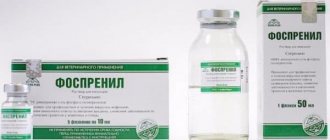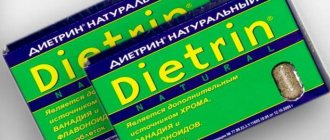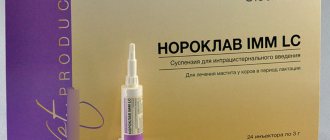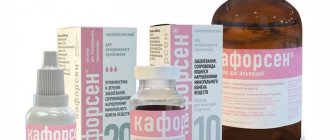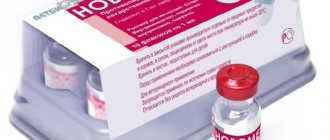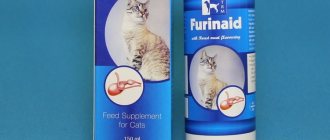Instructions for use for birds
Poultry for which Farmazin-500 is used:
- chickens (broilers, replacement chickens, breeding birds);
- turkeys.
During the treatment period, chickens and turkeys should not receive any other water to drink other than the medicinal solution.
General application scheme
The drug in powder form is diluted in drinking water. First, add a small amount of water to the recommended dose of the product, then add the remaining amount until the required concentration is reached. It is recommended to avoid exposure of the prepared solution to sunlight.
Did the drug Farmazin-500 for the treatment of farm birds and animals help you?
Not really
For what diseases is Farmazin used?
Farmazin
The veterinary medicine Farmazin 500 is used for the prevention or treatment of the following diseases in birds and animals:
- Avian respiratory mycoplasmosis. Affects all species, most often egg-laying chickens. In turkeys, the disease is called infectious sinusitis because the infraorbital space becomes inflamed. The bird loses its appetite, discharge appears from the beak, conjunctivitis begins, weight gain falls, and egg production decreases. The earrings and comb are turning pale. Ducks and geese limp and develop a “penguin” gait. The spread of the disease is facilitated by unbalanced feeding and improper maintenance.
- Pullorosis (salmonellosis, typhus). Chicks of turkeys and chickens suffer mainly in the first weeks of life. The disease is characterized by diarrhea, severe depression and high mortality. A bird that has recovered from the disease is a carrier of the infection. The spread of the disease is facilitated by unsanitary conditions and unbalanced feeding of the chicks with millet and boiled eggs.
- Swine dysentery. The disease causes the greatest damage to sucklings up to a month old. They become infected from sows or through contact with contaminated bedding, equipment, etc. Poor nutrition of mothers makes babies defenseless against adverse external factors.
- Bronchopneumonia of calves. The disease affects calves born weakened due to the poor quality of feed for cows. The development of the disease is facilitated by temperature changes, dust, and unbalanced nutrition.
Respiratory mycoplasmosis
A working solution for chickens of all ages is prepared from a ratio of 1 g of Farmazin-500 powder per liter of water. A fresh portion must be prepared daily.
Mycoplasmosis
Symptoms of the acute form: shortness of breath, sneezing, wheezing in the trachea, redness of the eyes and foamy discharge from them, decreased appetite and egg production
Read
Dosage and method of administration for adult birds
Algorithm for use for therapeutic purposes:
- Prepare a medicinal solution in the proportion of 10 g of the drug per 10 liters of drinking water . This amount is enough to feed 30 adult chickens per day.
- Course of treatment - 3 days.
Dosage and method of administration for chicks
Therapeutic drinking is carried out according to the following scheme:
- Dissolve 10 g of powder in 10 liters of drinking water . This volume is enough for a day to feed 52-53 chickens aged 1-9 weeks or 31 broiler chickens from 1 to 6 weeks.
- Treatment is carried out within 3 days.
Dosage and method of administration for poultry for prophylactic purposes
In order to prevent respiratory mycoplasmosis, according to the scheme specified by the manufacturer, birds are fed during certain age periods:
- Breeding poultry: 1-5 days old - the average amount of solution per day per 100 birds will be 5.5 l; at the age of 28-29, 56-57 and 140-141 days - 20.8 liters per day per 100 chickens.
- Replacement young animals: at the age of 1-3 days they will require an average of 3.8 liters of working solution per 100 birds per 24 hours, at the age of 28-29 days - 20.8 liters per 100 birds per day.
- For broilers aged 1-3 days, an average of 5.7 liters of Farmazin-500 solution per 100 birds per day will be required; a 28-29-day-old bird per 100 units should receive 20.8 liters of medicinal solution within 1 day.
The use of Tylosin for chickens for the treatment and prevention of respiratory mycoplasmosis
Read
Enrostin for chickens - quick relief from salmonellosis, mycoplasmosis and other infectious diseases
More details
Basic broad-spectrum antibiotics used to treat chickens and adult chickens
Look
First aid kit for broilers: chickens and adult birds. Necessity and mandatory groups of drugs
Further
Farmazin 50, broad-spectrum antibiotic
Details INSTRUCTIONS for the use of Farmazin 50 (Pharmasin 50)
COMPOSITION AND RELEASE FORM
Farmazin 50 is a medicinal product containing the antibiotic tylosin as an active substance in the form of a base in an organic solvent. Farmazin 50 contains 50 mg of tylosin in 1 ml. The drug is a pale yellow injection solution. They are produced in 50 ml bottles, which are placed in cardboard boxes.
PHARMACOLOGICAL PROPERTIES
Tylosin is an antibiotic from the macrolide group, active against most gram-positive and some gram-negative bacteria, including staphylococci, streptococci, corynebacteria, clostridia, pasteurella, erysipelothrix, spirochetes, chlamydia, Treponema chiodysentery and mycoplasmas. When administered intramuscularly, the antibiotic is well absorbed from the injection site into the blood and penetrates almost all organs and tissues of the body.
The highest levels of tylosin are achieved in the lungs, liver, mammary glands and kidneys.
After a single injection, the therapeutic concentration of the antibiotic remains in the body for at least 20 hours. In addition, due to the peculiarities of the mechanism of action, Farmazin 50 selectively accumulates in tissues with low pH values, that is, in areas of inflammation, providing a targeted effect.
Farmazin 50 also exhibits nonspecific immunostimulating and immunomodulating effects due to the inhibition of cytokines, activation of plasma cells and antibody production, activation of leukocyte chemotaxis and proliferation of lymphoid elements. Farmazin 50 accumulates in exceptionally high concentrations in the lysosomes of neutrophils, ensuring the completion of phagocytosis and rapid disposal of bacterial pathogens. The special composition of the organic solvent in the injectable Farmazin ensures high storage stability, optimal consistency for comfortable filling of the syringe and absolutely painless injections for the animal. The drug is excreted from the body mainly in feces, and in smaller quantities in urine and milk.
INDICATIONS
Prescribed for the treatment of bronchopneumonia of cattle and small ruminants, pigs, dogs and cats, enzootic pneumonia, arthritis, dysentery, atrophic rhinitis of pigs, infectious agalactia of sheep and goats, mastitis of cattle, skin and surgical infections, as well as for the prevention and treatment secondary infections in viral diseases.
DOSES AND METHOD OF APPLICATION
Farmazin 50 is administered to animals only intramuscularly once a day for 3 - 5 days in the following doses: cattle - 8 - 10 mg of active substance per 1 kg of animal weight, pigs - 10 - 12 mg of active substance per 1 kg of animal weight, sheep, goats, dogs and cats - 5 - 10 mg of active substance per 1 kg of animal weight. When repeated use, it is necessary to change the injection site.
SIDE EFFECTS
Very rarely, allergic reactions in pigs are possible in the form of erythema, itching, respiratory phenomena, mild swelling with slight prolapse of the rectum, which quickly disappear after stopping the use of the drug.
CONTRAINDICATIONS
Increased individual sensitivity to tylosin. It is not recommended to use Farmazin 50 simultaneously with tiamulin, clindamycin, chloramphenicol, penicillins (especially ampicillin and oxacillin), cephalosporins and lincomycin due to a pronounced decrease in the antibacterial effect of tylosin.
SPECIAL INSTRUCTIONS
Slaughter of animals for meat that have been treated with Farmazin 50 is permitted 8 days after stopping the administration of the drug. The meat of animals forcedly killed before the expiration of the specified period is used to feed carnivores or to produce meat and bone meal. Milk obtained from animals during the period of use of Farmazin 50 and until 4 days after the last administration of the drug is prohibited from being used for food purposes. This milk can be used to feed animals.
STORAGE CONDITIONS
With caution (list B). In a dry place, protected from light and out of reach of children and animals, at a temperature of 5 to 25 ° C
Shelf life: 3 years.
MANUFACTURER
Huvepharma AD, Bulgaria.
You can buy (purchase) Farmazin 50 at the Kotofey veterinary pharmacy, Dnepropetrovsk. Price to be confirmed.
Infectious sinusitis of turkeys
The preparation of the working solution is carried out in the same proportion as in the treatment of respiratory mycoplasmosis of chickens - 1 g of powder per liter of drinking water.
Dosage and method of administration
Algorithm for use for therapeutic purposes:
- Prepare a working solution from the ratio of 10 g of product per 10 liters of drinking water . This amount is enough to feed 17 adult heads or 29 units of young animals at the age of 1-9 weeks per day.
- Course of treatment – 5 days.
Feeding turkeys to prevent infectious sinusitis is carried out in accordance with the manufacturer’s scheme:
- at the age of 1-3 days - 5.56 liters per day per 100 heads;
- at 28-29 days - 79.5 liters per day per 100 turkeys.
Pharmacological properties of the drug
Farmazin has a wide spectrum of action and is effective for various diseases.
Farmizin is a veterinary antibiotic from the macrolide group. The active substance tylosin has a detrimental effect on most gram-positive and some gram-negative bacteria, including streptococci, staphylococci, pasteurella, vibrios, corynebacteria, microplasma, chlamydia, clostridia, erysipelothrix, spirochetes and treponema. The activity of the substance manifests itself at the ribosome level, weakening protein synthesis at the molecular level.
When administered intramuscularly, the drug is well absorbed from the injection site into the blood and distributed throughout all organs and tissues. The same mechanism of action is observed with oral consumption of powder or granules.
With a single dose of Farmazin, the therapeutic concentration is retained in the body for at least 20 hours when administered into a muscle, and more than 15-18 hours when used orally.
The use of Farmazin can significantly reduce the mortality of turkeys during the growing period.
The drug also has the ability to be selectively deposited in inflammatory foci, which makes it possible to provide a targeted effect. To obtain the most favorable results when treating with this antibiotic, it is recommended to test the causative agent for susceptibility to the active component - tylosin.
Farmazin has nonspecific immunostimulating and immunomodulating properties, and in extremely high concentrations accumulates in the lysosomes of neutrophils, which allows you to quickly get rid of pathogenic bacteria. Most of the drug is excreted from the body in feces; smaller amounts are excreted in urine, milk and eggs.
special instructions
The use of the drug requires compliance with the following rules and regulations:
- Poultry should be slaughtered for meat 5 days after stopping the medication. If this norm is not observed, the meat should be used for preparing meat and bone meal or as feed for carnivorous animals.
- When working with Farmazin-500, it is forbidden to eat, smoke or drink.
- Do not use empty medicine containers for household needs.
- Follow safety and personal hygiene rules.
Contraindications and possible side effects
Side effects are rare if the dosage of the medication is followed. In some cases, it is possible to develop an allergy to the drug. Treatment is symptomatic.
Contraindications to the use of the composition are as follows:
- individual intolerance to the drug or hypersensitivity to it;
- use of other antibiotics;
- kitten feeding period.
Be sure to read:
Duphalac ® for cats: dosage for constipation, how many times to give and instructions for use
Pregnant cats are prescribed medication only if there is no other treatment that is safe for the offspring.
What are the dosages?
The antibiotic is available in two forms:
Farmazin 500
Powder Farmazin 500 with a dosage of tylosin 500 mg. For ease of use, it is packaged in containers of 25 and 200 grams in plastic jars with lids or paper-plastic bags. Excipient: lactose monohydrate.
It is also accompanied by instructions, a mark (labeling) about the manufacturer, batch, expiration dates and conditions under which it is necessary to store, plus other necessary information.
The second packaging option is a solution for intramuscular injection of Farmazin 50, respectively, with a dosage of the active substance tylosin of 50 mg. Liquid Farmazin is packaged in 25 ml bottles. and 50 ml. sealed with rubber stoppers and clamped with aluminum caps.
The excipients here are: 1,2-propylene glycol and water. Each bottle is packed in a personal box, which is supplemented with instructions for using the drug.
Labeling in Russian, manufacturer’s designation (production address, company logo, company name), name of the drug, net volume in the bottle or pack, temperature conditions, permissible humidity and shelf life, batch number, clarification of what exactly is for “Intramuscular use” "or orally, and the sterility designation is the entire list of mandatory designations that must be present on each copy of the antibiotic for animals.
Pharmacological properties
Farmazin is a veterinary antibiotic from the macrolide group. Water-soluble fine-grained powder. Shades from white to cream, not the usual specific smell and bitter taste, but solutions for intramuscular injections - shades from transparent to light yellow. The active ingredient is tylosin.
Tylosin
Tylosin has a detrimental effect on:
- Streptococci
- Pasteurella
- Staphylococcus
- Corynebacteria
- Vibrios
- Microplasmas
- Clostridia
- Chlamydia
- Erysipelothrix
- Treponema
- Spirochetes.
The effect occurs at the ribosome level, suppressing protein synthesis at the molecular level.
The ribosome is the most important non-membrane organelle of a living cell, serving for the biosynthesis of protein from amino acids according to a given matrix based on genetic information provided by messenger RNA (mRNA).
Farmazin 500 dissolves in water, entering the body and spreading with the blood throughout the body, accumulating in higher concentrations in:
- liver to a greater extent,
- kidneys are smaller
- less lungs
- mammary glands - in dairy animals,
- eggs - in laying animals.
A single dose of the drug will maintain concentration to realize therapeutic properties for:
- farmazin 50 (for intramuscular administration) lasts more than 20 hours
- Farmazin 500 (for oral use) lasts more than 15-18 hours
Farmazin also has the property of selectively accumulating at the primary source of inflammation, which allows targeted action on the focus. For the most effective treatment, it is necessary to check the sensitivity of the pathogen to the active substance - tylosin.
The main part of the drug is excreted through the urethra, some comes out with stool and partly with breast milk or eggs.
Hazard level – moderate (class 3 according to GOST 12.1.007)
